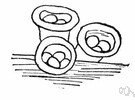pe·rid·i·um
(pə-rĭd′ē-əm)n. pl. pe·rid·i·a (-ē-ə)
The covering of the spore-bearing organ in many fungi.
[New Latin pēridium, from Greek pēridion, diminutive of pērā, leather pouch.]
pe·rid′i·al (-ē-əl) adj.
American Heritage® Dictionary of the English Language, Fifth Edition. Copyright © 2016 by Houghton Mifflin Harcourt Publishing Company. Published by Houghton Mifflin Harcourt Publishing Company. All rights reserved.
peridium
(pəˈrɪdɪəm)n, pl -ridia (-ˈrɪdɪə)
(Biology) the distinct outer layer of the spore-bearing organ in many fungi
[C19: from Greek pēridion a little wallet, from pēra leather bag, of obscure origin]
Collins English Dictionary – Complete and Unabridged, 12th Edition 2014 © HarperCollins Publishers 1991, 1994, 1998, 2000, 2003, 2006, 2007, 2009, 2011, 2014
pe•rid•i•um
(pəˈrɪd i əm)n., pl. -rid•e•a (-ˈrɪd i ə)
the outer enveloping coat of the fruiting body in many fungi.
[1815–25; < New Latin < Greek pērídion, diminutive of pḗra wallet; see -idium]
pe•rid′i•al, adj.
Random House Kernerman Webster's College Dictionary, © 2010 K Dictionaries Ltd. Copyright 2005, 1997, 1991 by Random House, Inc. All rights reserved.
ThesaurusAntonymsRelated WordsSynonymsLegend:
| Noun | 1. |  peridium - outer layer of the spore-bearing organ in many fungi peridium - outer layer of the spore-bearing organ in many fungicovering, natural covering, cover - a natural object that covers or envelops; "under a covering of dust"; "the fox was flushed from its cover" |
Based on WordNet 3.0, Farlex clipart collection. © 2003-2012 Princeton University, Farlex Inc.